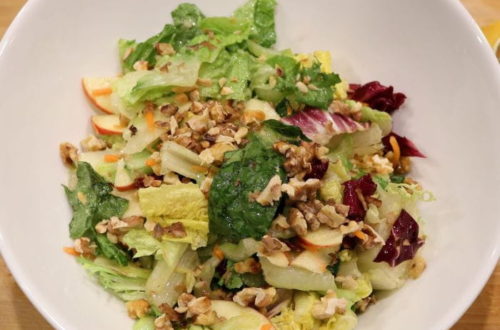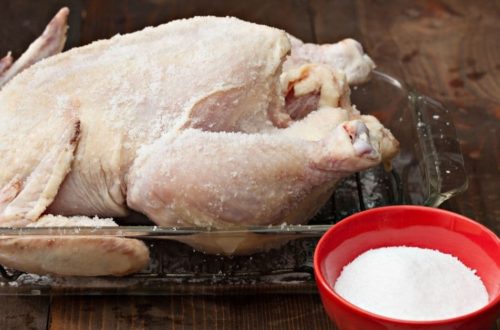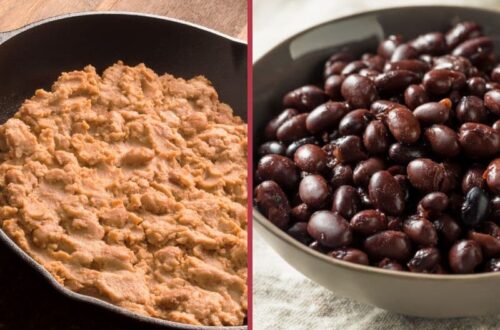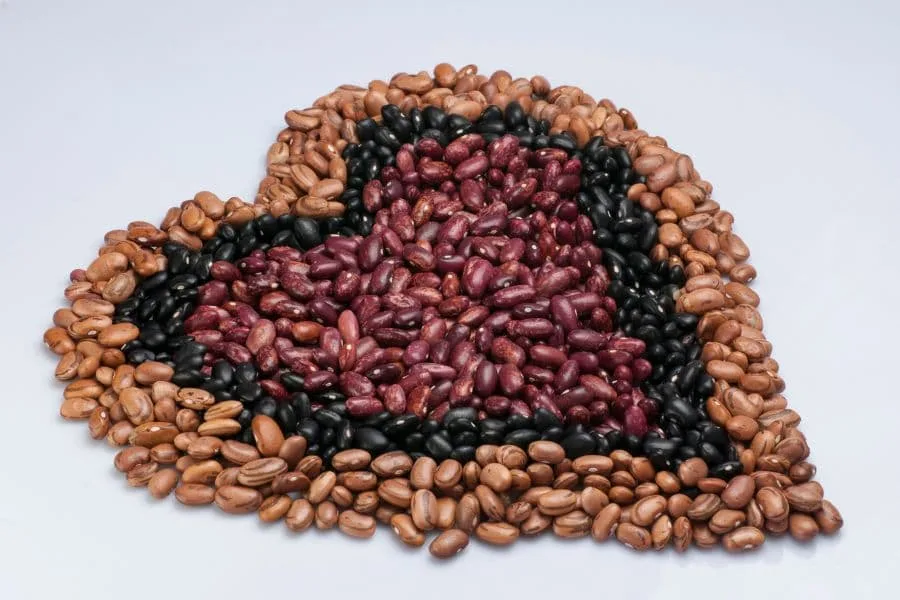
Black Beans vs Kidney Beans | How to Make a Healthy Choice
If you want to know the nutrition and benefits of black beans vs kidney beans then you are in the right place!
Ever go to your pantry to gather ingredients for dinner and notice you were missing a critical component? Then you have to search for a substitute for the missing key ingredient or go to the grocery store. Ugh.
I have done this several times when making beans and rice. I forgot to soak my black beans and had to substitute canned red kidney beans instead. But is there a big difference between the two?
Let’s dive in and find out more.
This post may contain affiliate links for products LSG loves. Lone Star Gatherings earns a small commission on these links at no additional cost to you. Please read my DISCLOSURE POLICY for more info.
History of Black Beans vs Kidney Beans
Black Beans
The black bean is a common bean and falls in the legume family. Its history in foods dates back thousands of years.

Did you know that Michigan is the second-largest producer of all dry beans in the United States? And, according to Michigan State University, it is the leader in the United States for the production of black beans.
Surprisingly, Mexico is the biggest importer in Central America of Michigan black beans.
Brazil is the largest producer and consumer of black beans in South America. However, India is the largest producer of dry beans worldwide. So, black beans are truly a global commodity.
Additionally, black beans are a significant staple in Latin American cuisine and in a variety of dishes from the region. Many regional recipes highlight cooking with chili peppers for a kick of spice in stews and are a key ingredient in many other dishes.
So, the black bean is one of the most common beans you can find in dishes around the globe. Moreover, it plays an important role in Korean, Chinese, Kenyan, and South Asian cuisines.
Kidney Beans
The kidney bean is also a variety of the common bean. It is named for its resemblance to a human kidney. However, this bean appears in different colors and sizes depending on where they are grown.
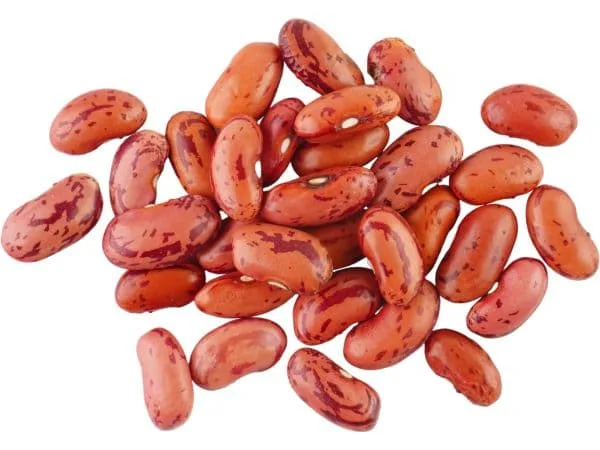
According to Wikipedia, there are four different classifications or types of kidney beans.
- Red Kidney Beans: known as the common kidney bean
- Light speckled kidney beans: long shape and lightly speckled
- Red speckled kidney beans: long shape with light speckling
- White kidney beans: also known as cannellini beans in Italy
Differences between Kidney and Black Beans
Both of these common beans are on the shelves of local grocery stores. However, there are some distinct differences between the two.
The main difference between black beans vs kidney beans is the color. The black bean varies only slightly, however, the kidney bean can be red, speckled, or white in color.
Another significant difference is the shape. Black beans are oval-shaped beans whereas kidney beans are named after the human kidney due to their common shape.
What are Black Beans Like? Taste and Texture
When properly cooked, both common beans can have a creamy texture with mild flavor.
Canned black beans or beans boiled with no additional flavoring have a bit of a nutty flavor which is different than some other beans.
They have a firm texture and are a great choice for adding to soups and stews to increase protein without having to add meat.
Pureed black beans are a good substitute for dairy products in foods. They are a great way to add a creamy flavor to soups without adding calories and fat of dairy products.
These beans take on the flavors of other ingredients which is one reason they are in so many dishes.
What are Kidney Beans Like? Taste and Texture
In contrast to black beans the flavor profile of kidney beans presents a slightly sweeter taste with an earthy flavor and slightly smoky aroma. Their firm texture makes them a good choice in many different recipes.
Their firmer texture is one of the reasons they are especially good in chili and hearty stews. And their sweet taste is a nice contrast to the heat found in some of these dishes.
Nutritional Profile of Black Beans vs Kidney Beans
Both beans are a great source of protein. They also contain 7-8 grams of fiber per ½ cup serving of canned beans and are considered part of a healthy diet for many reasons.
According to Healthline, black beans are a legume and are also a “pulse food”. This is a food group with a unique nutritional profile.
Want to learn about black beans vs refried beans? Check out the nutritional data of the two.
Black Bean Nutrition and Health Benefits
One-half cup serving of boiled, unsalted black beans contains the following:
- Calories: 113
- Protein: 8 grams
- Fat: 0.5 gram
- Carbs: 20 grams
- Fiber: 8 grams
- Folate: 32% of the daily value (DV)
- Copper: 20% of the DV
- Thiamine: 17% of the DV
- Manganese: 16% of the DV
- Magnesium: 15% of the DV
- Iron: 10% of the DV
- Phosphorus: 9% of the DV
- Potassium: 7% of the DV
- B Vitamins: 4% of the DV
- Calcium: 1% of the DV
- Selenium: 1% of the DV

As you can see, black beans are quite high in dietary fiber and plant-based grams of protein, two nutrients that help lower chronic disease risk.
Their protein is highly digestible and is an ecologically sustainable protein source when you compare it with animal-based sources.
This nutritious legume has high fiber content including soluble fiber, insoluble fiber, and resistant starch, all of which have many benefits
The fiber, potassium, folate, vitamin B6, and phytonutrient content of black beans along with their lack of cholesterol support heart health.
Black beans also provide calcium, selenium, vitamin B, and vitamin C. However, their overall mineral content can vary greatly depending on the beans’ origin.
The iron, phosphorus, calcium, magnesium, manganese, copper, and zinc in black beans all contribute to building and maintaining bone structure strength.
Additionally, potassium, calcium, and magnesium, help to decrease blood pressure naturally.
It’s worth considering that although black beans are a rich source of plant-based protein, they’re not a complete protein source. That means they don’t contain all nine essential amino acids that your body needs from food. For this reason, it is important to eat a balanced diet with a variety of plant-based foods that will provide all of the essential amino acids — as opposed to eating black beans only.
Kidney Bean Nutrition and Health Benefits
A half-cup serving of low-sodium canned kidney beans contains the following:
- Calories: 105
- Protein: 7 grams
- Fat: 1 gram
- Carbohydrates: 19 grams
- Fiber: 8 grams
- Sugars: 0.2 grams
- Sodium: 117 mg
- Calcium: 37 mg
- Potassium: 333 mg
- Iron: 2 mg
- Vitamin C: 1 mg
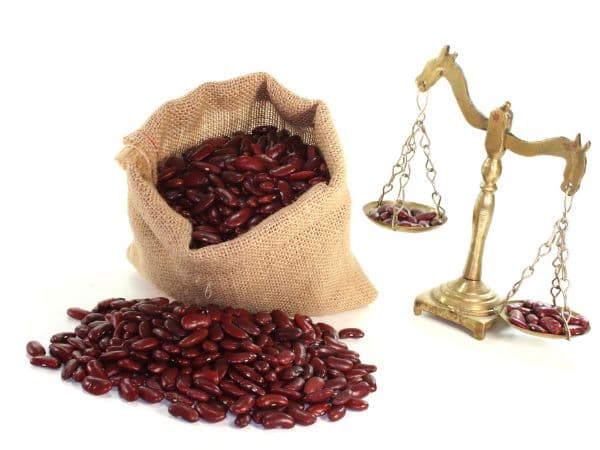
Kidney beans are also rich in various vitamins and minerals including the following:
- Folate: Folic acid or vitamin B9 which is particularly important during pregnancy.
- Iron: An essential mineral that helps many important functions in your body.
- Copper: This antioxidant element is typically low in the Western diet. Beans, organ meats, seafood, and nuts are the best dietary sources of copper.
- Potassium. This essential nutrient may have beneficial effects on heart health.
- Vitamin K1. Also known as phylloquinone, vitamin K1 is important for blood coagulation.
Kidney beans provide a good source of antioxidants which helps support your health in several ways. Their red hue comes from anthocyanins which is a group of antioxidants. These beans can help lower the risk of several chronic diseases, such as cancer, heart disease, and diabetes. They also promote good overall health.
Health Benefits of Black Beans vs Kidney Beans
Nutritionists recommend beans as part of a healthy diet because of their high nutritional value and essential nutrients. You can count these beans as a good source of protein as well as a vegetable.
Eating at least a half-cup of beans per-day can improve your overall health. Adding beans to your diet means you are taking in more fiber, protein, folate, iron, and other important minerals which can reduce your risk of heart disease and aid in weight loss.
Significant Health Benefits of Kidney and Black Beans
Improves Heart Health
Beans are an excellent option for protein in place of meat or other high-cholesterol protein sources. A half-cup of these beans can supply as much protein as 1 ounce of many animal-based proteins.
Also, reducing cholesterol is an excellent way to lower your risk of heart disease and reduce high blood pressure. Many studies indicate that eating beans significantly reduces low-density lipoprotein cholesterol or “bad” cholesterol and helps lower your risk of heart attack or stroke.
Supports Digestive Health
Beans have plenty of fiber, which can help promote better gastrointestinal health and reduce the chances of colon cancer. Beans supply prebiotic fiber which is indigestible by humans.
This prebiotic element acts as fuel for the beneficial bacteria in our gut. This is a good thing as it may help prevent gastrointestinal diseases like inflammatory bowel disease and irritable bowel syndrome. So, yeah fiber!
Controls Blood Sugar Levels
Beans are considered a low-glycemic index food. This means not only do they not cause spikes in blood sugar when eaten, but they can help moderate the effects of foods that do cause spikes in blood sugar. For instance, kidney and black beans in a beans and rice recipe can slow the rate at which the rice digests.
Healthy Choice for Diabetics
Data from a recent study in the Journal of Medicinal Food found that low-energy bean-based diets may help reduce insulin sensitivity or resistance and promote weight loss.
Helps Weight Management
Beans can be a powerful tool for dieters, especially when adopting a low-carbohydrate diet. The high fiber content combined with 7- 8 grams of plant-based protein in each half-cup serving of kidney or black beans can help people feel fuller longer and avoid overeating.
This makes beans an obvious food choice for those who want to lose pounds or maintain a healthy weight.

How to Cook Dry Black Beans vs Kidney Beans
Stove Top Method
The first step is to rinse the beans with cold water. Place the well-drained beans in a pot large enough to hold the beans and cover with fresh water. Add enough water to cover the beans by two inches. Add a teaspoon of salt and bring to a boil. Cooking time depends on a few factors like how long you soaked the beans or how old they are when cooking. However, boil the beans for 10 – 20 minutes and then simmer with the lid off for about 40 – 60 minutes or until soft. The longer they cook the creamier texture they produce. But don’t overcook as they do get mushy.
Pressure Cooker
You can also cook beans in a pressure cooker or Instant Pot. Add a tablespoon of olive oil to the pot to help reduce foaming while the beans cook. Pour in the soaked and rinsed beans and cover with a few inches of fresh water. Add a teaspoon of salt and cook at high pressure. Cook black beans for 20 – 25 minutes and kidney beans for 25 – 30 minutes. Let the pot naturally release or use quick release, but you may experience foaming.
Notes About Cooking Dry Beans
You do not have to soak your beans overnight, but it makes for a better-looking bean when you use the pressure cooker.
It is VERY IMPORTANT to boil red kidney beans for 10 minutes before adding them to the pressure cooker. Boiling them removes a specific lectin found in kidney beans or red beans. High levels of this lectin found in raw or undercooked kidney beans can act as a toxin and cause food poisoning.
How to Store Beans
The shelf life of dry beans is a very long time. Be sure to store them in a dry place.
Let cooked beans cool completely, then store in their liquid in the refrigerator for up to 5 days.
Additionally, you can freeze cooked beans. I put them in ziplock bags as they take up less space. Freeze for up to three months.
Other Kinds of Common Beans
There are many different types of beans found in the common bean family.

Navy Beans
These beans or haricot beans are particularly popular in the United Kingdom and the United States. Other white beans include cannellini, a popular variety in central and southern Italy that is related to the kidney bean. White beans are the most abundant plant-based source of phosphatidylserine. This is a major acidic phospholipid class found in the human cerebral cortex.
Black-eyed Peas are also Beans
Great music! But the food is good too. The black-eyed pea is a legume grown around the world for its medium-sized, edible bean. It originates from West Africa and has been cultivated in China and India since prehistoric times. It is also grown in America and is considered a Lucky New Year Food as well as a staple in the south.
Garbanzo Beans
Or Chickpeas are high in protein. It is one of the earliest cultivated legumes and is a key ingredient in Mediterranean and Middle Eastern cuisines. Hello hummus!
Pinto Beans
The dried pinto bean is the bean most commonly used reconstituted or canned in many dishes. It is especially popular when prepared as refried beans. It is commonly found in chili or chili con carne, although kidney beans and black beans may be used as well. Pinto beans are often found in Brazilian cuisine.
Other Common Beans
- Small Red Beans: Small, plump, oval-shaped red beans that resemble small rounded kidney beans. They have a mild flavor and creamy texture and are commonly found in South American and Caribbean cuisines.
- Mung Beans: The mung bean is mainly cultivated in East, Southeast and South Asia and is used as an ingredient in both savory and sweet dishes.
- Fava Beans: This legume is very common in Southern European, Northern European, East Asian, Latin American and North African cuisines. Serve with a nice Chianti. (Slurp!)
- Cranberry Beans: These originated in Colombia as the cargamanto bean. It is an oval shaped white bean with red speckles. They are often found in Italian and Mediterranean cuisine.
- Black Turtle Beans: According to Wikipedia, the black turtle bean is the only type of turtle bean. It is called turtle because of its hard outer “shell”. This black bean is especially popular in Latin American cuisine, though it can also be found in the Cajun and Creole cuisines of south Louisiana. Like all varieties of the common bean, it is native to the Americas, but has become a global commodity. It is not to be confused with douchi, the Chinese dish made with black-hulled soybeans.
Recipes for Black Beans
There are many great recipes for black beans, but two of my favorites are Easy Black Beans and Rice with Sausage and Slow Cooker Mexican Black Beans.
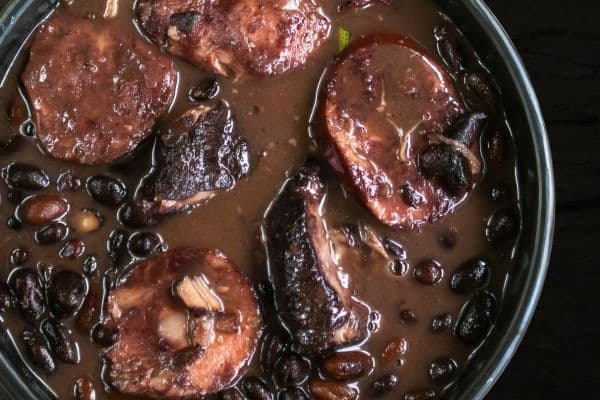
The Easy Black Beans and Rice with Sausage recipe calls for a slow cooker that allows you to focus on other things while your main dish cooks. It is a great recipe for entertaining a large crowd as well. White rice is one of the most popular choices for the base of this dish. However, I use brown rice frequently for additional fiber in my meals.
Pair it with homemade cornbread and a simple salad for a complete meal. You can even use the leftover beans and sausage to make a black bean soup.
I opt for this Slow Cooker Mexican Black Beans recipe instead of refried beans when I cook TexMex. It is a healthier option and goes great with Fajitas. It is also an excellent side dish for any cookout.
Black Beans vs Kidney Beans: Both are Healthy Choices
Whether you include black beans or kidney beans in your meal planning rotation comes down to personal preference. Both are quite healthy and can make a great addition to any meal or star as the main attraction. They are excellent choices for good protein when you make a meatless meal.
Cheers Y’all!
P.S. Please share this post on your favorite social media site! And comment below. I appreciate your thoughts.



